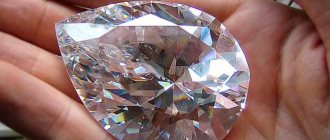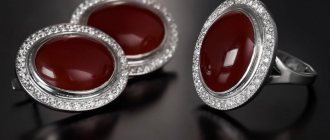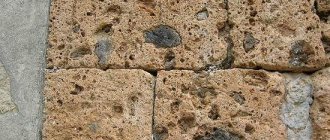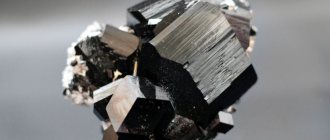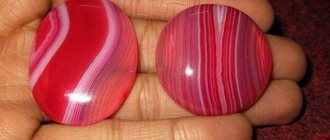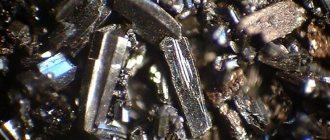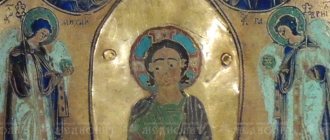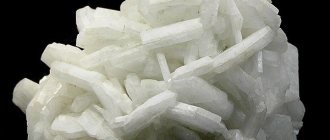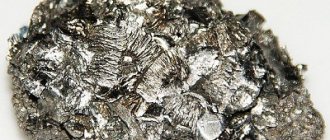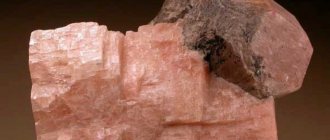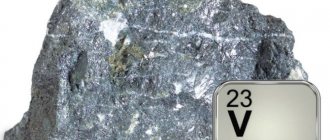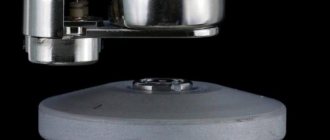Plagioclases are an isomorphic series between sodium-alkaline (albite, analbite, monalbite) and calcium-alkaline earth (P-anorthite, I-anorthite) end members, in which, simultaneously with the replacement of Na by Ca, an equivalent part of Si is replaced by Al. The composition of plagioclase is usually characterized by its number corresponding to the content of the anorthite component (An0-An100).
origin of name
The name of the mineral comes from the Greek “plagios” - oblique, inclined and “oasis” - fracture, emphasizing that the angle between the cleavage planes (001) and (010) is significantly different from straight (from 86°24′ in albite to 86°50′ in anorthitis).
Plagioclase. Adular. The natural intergrowth of crystals is a quadrangle
The English name for plagioclases is Sodium-calcium feldspars (plagioclases)
What is
Plagioclase is a group of minerals of complex structure with impurities and a “two-series” formula.
It belongs to the group of feldspars, so it is quite correct to call plagioclase spar.
Plagioclase mineral does two things:
- aluminosilicate “frame”;
- calcium or sodium as essential components.
At the suggestion of the Soviet academician E. Fedorov, instead of naming, plagioclases are numbered. The number reflects the percentage of anorthite in the composition.
Based on this characteristic, the main types are identified: albite, oligoclase, andesine, bytownite, labradorite, anorite.
Plagioclase albite is devoid of calcium, the anorthite formula does not contain sodium. Other minerals of the group are a mixture of albite and anorthite. For example, plagioclase No. 67 is 67% anorite plus 33% albite.
Weathering turns beautiful pebbles into mica or clay (kaolin), hot springs create chlorite or zoisite.
In igneous rocks, zoned plagioclase is found, formed as a result of instantaneous crystallization of the melt.
The origin may be thermal or metamorphic.
Mineral Change
Plagioclases in the weathering crust are less stable than potassium feldspars and change before it. Albite is the most stable, calcium plagioclases the least stable. With hypergene alteration of albite-oligoclase and oligoclase, halloysite is formed, after andesine, labradorite and bitownite - montnorillonite, less often halloysite (unlike potassium feldspars, after which kaolinite develops). Halloysite replaces oligoclase without the formation of any intermediate phases, growing on it epitaxically in the same orientation as kaolinite on microcline. Initially, lamellar crystallites of halloysite are formed, from which radiating rays extend from the edges, twisting into tubular crystals typical of halloysite; in each ray, diamond-shaped halloysite layers overlap each other in a tiled manner so that the b axes in them make an angle of 90, or 60, or 30° with the axis of the beam.
In the weathering crust of the gabbro of the Novoburanovsky nickel deposit (Kempirsay ore cluster, North-West Kazakhstan), zonal bauxite nodules were observed, formed during the replacement of bytownite. Directly along the plagioclase rock, a zone of “rice-like” halloysite-10A (rolled tubes with a diameter of 0.05-0.1 microns, a length of 0.2-0.3 microns) of a block-mosaic structure is formed, turning into a gibbsite zone. In the outer parts of the gibbsite zone, halloysite is formed again in the form of diamond-shaped plate-shaped new formations of halloysite-7A, turning into spirally twisted tubes (0.2-0.3 µm wide and 3-5 µm long). The successive replacement of bytownite with disordered halloysite-10A, its dissolution and replacement with gibbsite, and the new formation of ordered halloysite-7A is associated with the neutralization of alkaline (pH ~ 10) solutions and their further acidification. On the island of Pinos, near the city of New Gerona (Cuba), labradorite (An50-58) quartz monzonite is replaced by gibbsite. Poikilitic inclusions of plagioclase in monzonite orthoclase are also replaced by gibbsite. The Labradorite weathered gabbro dyke in the Mayari-Baracoa ultramafic massif (Punta Gorda nickel deposit in the Moa region, Orinte Province, Cuba) is replaced mainly by gibbsite, but spherulites (0.1-0.2 µm) of halloysite are found on the surface of the replaced plagioclase. The Labradorite of a weathered dyke of amphibolized gabbro at the Sol Libano nickel deposit (Cuba) is replaced by goethite with an admixture of halloysite, while gibbsite is absent here. Labradorite (An41-53) anorthosite from Volyn (Ukraine) is replaced by montmorillonite. Montmorillonite also develops along labradorite in the weathering crust at the Golovinsky labradorite deposit (Ukraine); its subsequent replacement by gibbsite in the upper parts of the profile is explained by the acidification of alkaline solutions. In the Paleogene weathering crusts on Olkhon Island (Lake Baikal), no selectivity in the dissolution of feldspars was observed, and different clay minerals grow on the surface of the same plagioclase (or microcline). In the lower zone of the crust over acidic rocks (leucocratic microcline granites), oligoclase-andesine An30 is replaced by di- and trioctahedral montmorillonite, in the middle zone microcline and plagioclase are replaced by halloysite and dioctahedral montmorillonite, and in the near-surface zone, with the complete destruction of plagioclase, halloysite and kaolinite appear. In all crustal zones of the main rocks (amphibolites), andesine-labradorite An50 is replaced by di- and trioctahedral montmorillonite (amphibole - trioctahedral) and in the middle and near-surface zones (with complete decomposition of plagioclase) kaolinite appears. The mineral composition of clay minerals is determined by the chemical composition of the rocks and changes in the pH of circulating solutions. Interplanar distances of plagioclases are characterized by the presence of reflections, which, when indexed in a 14 A cell, can be divided into four types: “a” - (h + k - even, / - odd), "b" - (h + k - odd ., l - odd), “c” - (h + k - even, l - even) and “d” - (h + k - odd, l - even). Strong “a” reflections on layer lines, which appear during rotation or rocking around the c axis, corresponding to the 7 A cell, are characteristic of all plagioclases. Weaker “b” reflections, which appear in the middle between the layer lines during rotation or rocking around the c axis, indicate the presence of anorthite-type Si/Al ordering and a 14 A cell and are absent in the albite structure. The simultaneous presence of “a” and “b” reflexes is characteristic of body-centered anorthitis. They are observed in annealed and annealed plagioclases of composition An60-100. The presence of weak “c”-reflexes and even weaker “d”-reflexes indicates a displacement of the Ca atom to the wall of the cavity occupied by a large M-cation in (Al,Si)0-Kapkace and is characteristic only of primitive anorthite (c is also equal to 14 A). All four types of reflections are present in the structure of primitive anorthite and are observed in slowly cooled plagioclases of composition An60-100. With an increase in the content of the Na component, the “b”-, “c”- and “d” reflections weaken, become diffuse and do not appear in acid plagioclases of composition An100-40 An0-60. Slowly cooled plagioclases with a total composition ranging from oligoclase ~ An5 to bytownite ~ An75 (in intrusive or metamorphic rocks) exhibit decomposition into domains with albite and anorthite structures, coherently linked in a partially ordered overall lattice. Their X-ray patterns show “e” reflections, which are pairs of symmetrically split “b” reflections of anorthite, corresponding to the antiphase growth of small domains, geometrically connected into a structure characteristic of solid solutions of body-centered anorthite (I-anorthite) and at the same time indicating redistribution of Al to the T10 position, as is typical for solid solutions with a low albite structure. The structural interpretation of “e''-reflexes is also compatible with the hypothesis of the intergrowth of low albite domains with domains of primitive anorthite (P-anorthite), which are most stable at low temperatures. The isolation of “e''-reflexes and their diffuseness increase with increasing content of the Ab component within An50-15, while “c” reflections are observed only in samples with an An-component content of more than 50%. “f”-reflexes, which are pairs of symmetrically split “a''-reflections, are observed within An50-75. Thus, the An 50 composition is a discontinuity area between the Na- and Ca-domains for the entire plagioclase series, but in the areas of peristerites, Böggild and Huttenloscher “e” superstructures with pairs of “e1” and “e2” reflections are observed, corresponding to more sodium and more calcium differences in phase decomposition products.
Physico-chemical characteristics
According to the chemical classification, the mineral plagioclase is considered a silicate. Structurally, it is a continuous series with albite and anorthite as the extreme members.
| Color | white, gray, pink, greenish, brownish |
| Stroke color | white |
| origin of name | from the Greek πλάγιος - oblique and κλάσις - breaking, splitting, which means slanting." |
| Opening year | known since ancient times |
| Chemical formula | (Ca,Na)(Al,Si)[AlSi2O8] |
| Shine | glass |
| Transparency | transparent translucent translucent |
| Kink | stepped |
| Hardness | 6 6,5 |
| Density (measured) | 2.6-2.8 |
| Classes on taxonomy of the USSR | Silicates |
| IMA classes | Silicates |
| singonia | triclinic |
Color, melting point, and other properties are determined by the ratio of elements in the composition.
Within the group, individual mineral species are distinguished according to the content of the anorthite component (or according to the ratio 100*Ca/(Ca+Na) at.%):
| Mineral | Content, % | ||||
| Na2O | CaO | Al2O3 | SiO2 | Albit—anorthite | |
| Albite | 11,8 | 19,4 | 68,6 | Ab(0-l0An) | |
| Oligoclase | 8,7 | 5,2 | 23,9 | 62,1 | 70Ab—30An |
| Andesine | 5,7 | 10,3 | 28,3 | 55,7 | 50Ab—50An |
| Labrador | 4,0 | 13,3 | 31,8 | 51,9 | 30Аb—70Аn |
| Bytovnit | 1,6 | 17,2 | 34,2 | 46,9 | 10Ab—90An |
| Anorthitis | 20,1 | 36,6 | 43,3 | An(0-l0Ab) | |
Breed classification
The range of this breed is quite extensive, it consists of the following orders:
- Labradors. The main component of igneous rock with minimal silica content. Specimens include inclusions of ilmenite, titanium and magnetite. The main deposit of San Polo.
- Albites. Representative of the silicate class. The most common and in demand. It has a huge color background, ranging from pale blue and gray-yellow to almost transparent (colorless).
- Anorthitis. A very fragile stone with a pronounced glassy luster. It is characterized by transparency and glassy luster, which disappears when weathered.
- Andesites. Rock formations with crystal cleavage with an unusual tabular appearance. Characterized by transparency and shine. Most often formed in igneous rocks.
- Oligoclases. Tabular formations of crystals in red, yellow or gray colors. The second name is sun stone. Widely used in jewelry.
- Bytovnites. It is very difficult to find this mineral in the form of crystals. Most often these are isomorphic anorthosites.
Where is it used?
Minerals have found application in various fields:
- Jewelers are in demand for the most beautiful varieties: albite, belomorite, labradorite and its soft cream “relative” bytownite, specimens with an aventurine effect.
- Small items (figurines, balls) are created by master stone-cutters.
- Wear-resistant, impressive labradorite is a high-status finishing raw material for interiors and monuments.
In the light, plagioclase in thin section shimmers like a rainbow.
- Substandard (by the standards of jewelers and decorators) is used in the production of ceramics, porcelain, earthenware, cosmetics, and agricultural fertilizers.
The ultimate goal of collectors is a pebble from an asteroid or the Moon.
Field
Plagioclase is a very common stone and finding it is not difficult.
Along with it, pyroxene, quartz, hornblende and magnetite are often formed. Huge deposits of stone are located in Ukraine in the Zhitomir region. It is also found in the Russian Federation in the Urals, Kamchatka, Siberia and North Karelia. High quality mineral deposits are located in Switzerland. Zimbabwe, USA and on the island of Madagascar.
How to distinguish
Plastic or glass is offered under the guise of plagioclase samples. It is easy to recognize such an imitation by its lightness and rapid heating in the hands.
More often the mineral acts as a “back-up” for adularia. They look similar, but you can tell one from the other:
- Plagioclases are transparent, warm in color, sometimes with a yellowish tint. Their fracturing is visible to the naked eye.
- Moonstones are bluish-cold, slightly cloudy. Cracks can be seen under a magnifying glass.
Plagioclase can be considered a fake only in terms of price (adularia is many times more expensive), since it is a natural gem and not synthetic.
Applications of plagioclase
Interestingly, plagioclase in some cases acts as a gemstone.
Or rather, we are talking about its varieties:
- Labrador;
- andesine;
- aventurine (sunstone);
- albite.
Albite crystals, if they are large, are also ground and used in jewelry. They have a rather beautiful glow, and are often confused with various precious stones.
In any case, this is many times better than buying jewelry with plastic or glass stones that will not last even a couple of years.
Albit, for example, can last for decades without fading or crumbling, all because plagioclase is a very hard and dense stone.
But, for example, Labrador retriever has a beautiful greenish tint. More often than others, it is used in the cladding of buildings. It looks very beautiful and expensive.
The main thing is that it is strong and durable. It is also used for finishing and decorating the interior of buildings; it is often used in the decoration of monuments.
But the weathering products of plagioclase are often used in the porcelain and ceramic industries. The whole point is that they make porcelain much stronger, it does not crack or chip.
There are substitutes for this substance, but you need to understand that they are not natural and, therefore, can be harmful to health to some extent.
Magic properties
Sorcerers use the mineral as the focus of the power of the Moon and the Sun.
The magical properties of plagioclase are useful for ordinary people:
- Wearing an amulet is indicated for people who are emotionally vulnerable, prone to aggression, or work in stressful conditions.
- The stone is recommended for those who want to think clearly and make decisions quickly.
- This is a talisman for workers in risky professions and solo travelers.
- Activates the ability to clairvoyance, helps concentration and visualization.
- To protect the home from negativity, a pebble is strengthened at the entrance.
The Chinese wear albite to harmonize themselves with people and nature.
For Russia, the magic of the Labradorite Hyperborean stone is of particular importance.
Plagioclase stones are fragile; magical, medicinal artifacts and jewelry must be taken care of carefully.
A little bit of magic
The crystal, in addition to healing properties, is also endowed with magical properties.
Since ancient times, astrologers, magicians and wizards have used it for various purposes. For example, astrologers claim that this mineral is an excellent conductor of energy between the Sun and the Moon. In this regard, magical rituals require the presence of at least 2 copies. Practicing magicians use plagioclase to relieve a person of stress, nervousness, and tension. An amulet with albite is recommended to be worn by people who are particularly emotional and susceptible to external irritants. However, in a single copy its impact will be very weak. That is why it is desirable that the amulet consist of a pair of stones. A pair of them will contribute to the acquisition of wisdom and clarity of mind by those who own them. Such talismans have significant power. It is recommended for those who like to travel to have this mineral with them. With its help, a wandering person will be able to avoid various dangers.
Chinese tradition uses the described mineral to create harmony in the inner world of a person and his environment. It is believed that to achieve such harmony, a person needs to possess the energies of Yin and Yang in the same ratio. If there is an excess of one of the forces, it is necessary to normalize it by adding the force that is missing. Thanks to lunar albite, you can attract Yin energy, and with the help of solar albite, you can attract Yang energy.
To give the stones the appropriate strength, one of them should be charged with the light of the Moon, and the other with the light of the Sun. It is important that lunar plagioclase is laid out on the windowsill during the new moon. In addition, you need to ensure that moonlight falls on the crystal. To preserve its magical properties, it is recommended to put the pebble in a dark place during the day, for example, in a box. Similar actions are performed with solar albite only during daylight hours.
The crystal, in addition to healing, is also endowed with magical properties.
This mineral is endowed with other magical qualities. Thus, thanks to him, a person learns a philosophical attitude towards everything that happens in his life. It benefits not only the person, but also his home. For example, there is an opinion that if you place a crystal on the front door of your home, it will be cleared of external negativity. In this case, the magic stone should be located on the outside of the door.
Plagioclase belongs to the water element, its miraculous properties are associated with the lunar cycles of ebb and flow. This circumstance made the mineral a symbol of the infinity of life. Interestingly, there is no specific zodiac sign that it suits. It can be worn as an amulet by water, fire, air, and earth signs. However, some astrologers still recommend plagioclase to the signs of Water (Scorpio, Cancer, Pisces) and Leo.
Thus, albite is a mineral that can be used for medicinal and magical purposes. Its advantage is its low price compared to precious and even semi-precious stones.
